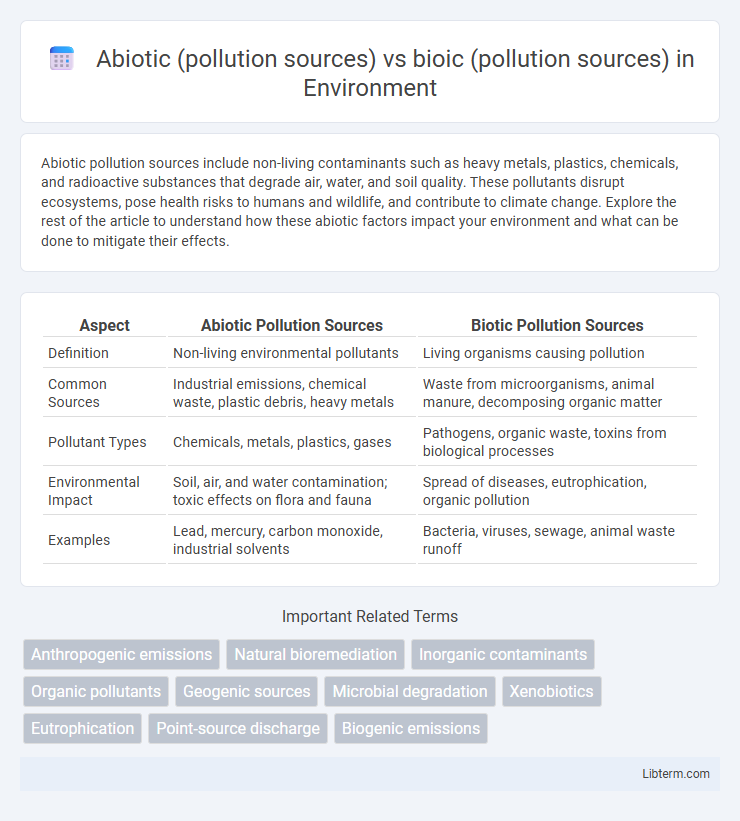Abiotic pollution sources include non-living contaminants such as heavy metals, plastics, chemicals, and radioactive substances that degrade air, water, and soil quality. These pollutants disrupt ecosystems, pose health risks to humans and wildlife, and contribute to climate change. Explore the rest of the article to understand how these abiotic factors impact your environment and what can be done to mitigate their effects.
Table of Comparison
| Aspect | Abiotic Pollution Sources | Biotic Pollution Sources |
|---|---|---|
| Definition | Non-living environmental pollutants | Living organisms causing pollution |
| Common Sources | Industrial emissions, chemical waste, plastic debris, heavy metals | Waste from microorganisms, animal manure, decomposing organic matter |
| Pollutant Types | Chemicals, metals, plastics, gases | Pathogens, organic waste, toxins from biological processes |
| Environmental Impact | Soil, air, and water contamination; toxic effects on flora and fauna | Spread of diseases, eutrophication, organic pollution |
| Examples | Lead, mercury, carbon monoxide, industrial solvents | Bacteria, viruses, sewage, animal waste runoff |
Introduction to Pollution Sources
Abiotic pollution sources include chemical contaminants such as heavy metals, pesticides, and industrial waste that disrupt ecosystems through non-living environmental factors. Biotic pollution sources involve living organisms like invasive species, pathogens, and excessive nutrient loads from biological activities that alter habitat balance and biodiversity. Understanding the distinction between abiotic and biotic pollution sources is critical for targeted environmental management and pollution mitigation strategies.
Defining Abiotic Pollution Sources
Abiotic pollution sources refer to non-living environmental contaminants such as chemical substances, heavy metals, and physical pollutants like plastic debris and radiation, which originate from industrial, agricultural, and urban activities. These pollutants disrupt ecosystems by altering soil composition, water quality, and air purity, leading to negative impacts on both flora and fauna. Understanding abiotic pollution sources is crucial for developing targeted mitigation strategies to preserve environmental health and biodiversity.
Key Examples of Abiotic Pollution
Key examples of abiotic pollution include chemical contaminants such as heavy metals (lead, mercury, cadmium), industrial effluents containing toxic substances, and plastics and microplastics that accumulate in aquatic and terrestrial ecosystems. Other significant abiotic pollutants consist of air pollutants like sulfur dioxide (SO2), nitrogen oxides (NOx), particulate matter, and greenhouse gases (CO2, methane) that contribute to climate change and acid rain. These abiotic pollutants originate from non-living sources such as factories, vehicles, mining activities, and agricultural runoff, contrasting with bioic pollution caused by living organisms.
Understanding Biotic Pollution Sources
Biotic pollution sources originate from living organisms, including invasive species, pathogens, and organic waste, which disrupt ecosystem balance and biodiversity. These sources contribute to water and soil contamination through the introduction of harmful bacteria, viruses, and excessive nutrient loads from decomposing organic matter. Understanding biotic pollution involves recognizing its impact on natural habitat health, disease proliferation, and the alteration of native species populations.
Common Examples of Biotic Pollution
Common examples of biotic pollution include invasive species such as zebra mussels, kudzu, and Burmese pythons that disrupt native ecosystems by outcompeting local flora and fauna. Pathogenic microorganisms like bacteria and viruses introduced through sewage discharge or agricultural runoff also contribute to biotic pollution by causing disease outbreaks in wildlife and humans. Additionally, excessive algal blooms driven by nutrient-rich runoff from fertilizers represent a significant biotic pollutant affecting aquatic environments.
Major Differences: Abiotic vs. Biotic Pollution
Abiotic pollution sources include non-living contaminants such as heavy metals, plastic waste, chemical runoff, and industrial emissions that disrupt ecosystems by altering physical and chemical environmental factors. Biotic pollution sources involve living organisms like invasive species, microbial pathogens, and algae blooms that impact native biodiversity, nutrient cycles, and ecosystem health. Key differences lie in the origin of pollutants--abiotic originates from inorganic or synthetic substances, whereas biotic pollution stems from living organisms causing biological imbalance.
Environmental Impact of Abiotic Sources
Abiotic pollution sources, such as chemical spills, heavy metals, and plastic debris, lead to long-lasting contamination of soil, water, and air, significantly disrupting ecosystems by altering pH levels, reducing biodiversity, and impairing natural biological functions. These pollutants often accumulate in the environment, causing toxic effects that affect both wildlife and human health over extended periods. In contrast, biotic pollution sources typically involve organic waste and invasive species that primarily influence environmental dynamics through biological interactions and nutrient cycles rather than persistent chemical toxicity.
Ecological Effects of Biotic Sources
Biotic pollution sources, such as invasive species, pathogens, and organic waste, disrupt native ecosystems by altering food webs, reducing biodiversity, and spreading diseases. These biological pollutants can cause ecological imbalances through the introduction of non-native organisms that outcompete or prey on indigenous species, leading to habitat degradation. Unlike abiotic pollution, which mainly involves chemical contaminants and physical disturbances, biotic pollution directly modifies ecosystem dynamics and resilience.
Control Measures for Abiotic and Biotic Pollution
Control measures for abiotic pollution sources, such as chemical contaminants, heavy metals, and particulate matter, emphasize reducing emissions through advanced filtration systems, strict regulatory standards, and sustainable industrial practices. Biotic pollution control focuses on managing invasive species, pathogens, and organic waste by implementing biological control agents, habitat restoration, and effective waste treatment processes to maintain ecological balance. Both approaches require continuous monitoring, early detection systems, and public awareness to minimize environmental and health impacts.
Conclusion: Addressing All Pollution Origins
Abiotic pollution sources, such as chemical runoff, heavy metals, and industrial emissions, disrupt ecosystems through non-living contaminants, while biotic pollution sources involve living organisms like invasive species and pathogenic bacteria that alter biological communities. Effective environmental management requires integrated strategies targeting both abiotic pollutants and biotic disruptors to safeguard ecosystem health and biodiversity. Comprehensive monitoring and remediation efforts addressing chemical, physical, and biological pollution origins are essential for sustainable environmental protection.
Abiotic (pollution sources) Infographic

 libterm.com
libterm.com